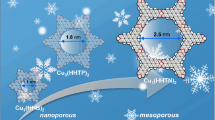Abstract
The crystal structure of the charge-transfer slat (CpFe+Cp)3[WVWVI 5O19] (CpFeCp=Fe(C5H5)2), synthesized from the reaction of Na2WO4⋅2H2O with ferrocene under acid conditions, has been determined by single-crystal X-ray diffraction. The crystal is of triclinic space group P(−1) with a=13.0374(3), b=15.0406(3), c=16.8239(1) Å, α=91.417(1), β=98.931(1), γ=115.294(1)°, V=2931.20(9) Å3, Z=1, M r =5895.57, F(000)=2652, μ=18.735 mm−1, and D c =3.340 g⋅cm−3. The final R factor is 0.0502 for 10173 (R int=0.0563) unique reflections and 770 parameters. The structural analysis reveals that there are two crystallographically distinct [WVWVI 5O19]3− polyoxoanions and six independent ferrocene cations per unit cell. Each polyoxoanion consists of six WO6 octahedra with three types of W–O bond lengths. Interestingly, CpFe+Cp moieties are stacked to form octagonal channels that incorporate the polyanions. The closest Fe⋅⋅⋅Fe distances between the neighboring ferrocenyl cations are more than 6.49 Å, therefore, a good magnetic isolation between the iron centers is expected.
Similar content being viewed by others
References
(a) M. T. Pope and A. Müller (1991). Angew. Chem. Int. Ed. Engl. 30, 34.
(b) A comprehensive review on polyoxometalates has been given by Prof. C. W. Louis, et al. (1998). Chem. Rev. 98, 3-390.
J. S. Miller, A. J. Epstein, and W. M. Reiff (1988). Chem. Rev. 88, 201.
P. L. Veya and J. K. Kochi (1995). J. Organomet. Chem. 488, C4.
P. L. Maguerès, L. Ouahab, S. Golhen, D. Grandjean, O. Pe~na, J. C. Jegaden, C. J. Gomez-Garcia, and P. Delhaès (1994). Inorg. Chem. 33, 5180.
S. Golhen, L. Ouahab, D. Grandjean, and P. Molinié (1998). Inorg. Chem. 37, 1499.
M. Che, M. Fournier, and J. P. Launay (1979). J. Chem. Phys. 71, 1954.
A series of hexamolybdate and hexatungstate salts have been reported. The geometry of these polyoxometalate clusters does not present significant changes. For more details, please see: H. R. Allcock, E. C. Bissell, and E. T. Shawl (1973). Inorg. Chem. 12, 2963.
N. E. Brese and M. O'Keeffe (1991). Acta. Cryst. B 47, 192.
Author information
Authors and Affiliations
Corresponding author
Rights and permissions
About this article
Cite this article
Yang, WB., Lu, CZ., Wu, CD. et al. Synthesis, Structural Characterization, and Magnetic Properties of a New Charge-Transfer Salt Composed of Polyoxotungstate Acceptors [WVWVI 5O19]3− and Cationic Ferrocenyl CpFe+Cp Donors. Journal of Cluster Science 14, 421–430 (2003). https://doi.org/10.1023/B:JOCL.0000005073.31400.57
Issue Date:
DOI: https://doi.org/10.1023/B:JOCL.0000005073.31400.57




